https://doi.org/10.22267/rtend.252602.280
Research Article
Social change and migration
Intradepartmental migration in Pasto and
socioeconomic, political, and cultural context of Nariño (Colombia)
Migración intradepartamental en Pasto y
contexto socioeconómico, político y cultural de Nariño (Colombia)
Migração intradepartamental em Pasto e
contexto socioeconômico, político e cultural de Nariño (Colombia)
Por:1 Francisco Javier Villamarín Martínez ![]()
1 Doctor in Social Studies from Universidad Externado de Colombia, Full-Time Professor of the Sociology Program at Universidad de Nariño, ORCID: 0000-0002-1506-7756. E-mail: paches74@udenar.edu.co, Pasto - Colombia.
Received: November 11, 2024
Accepted: March 10, 2025
DOI: https://doi.org/10.22267/rtend.252602.280
How to cite this article: Villamarín, F. (2025). Intradepartmental migration in Pasto and socioeconomic, political and cultural context of Nariño (Colombia). Tendencias, 26(2), 186-216. https://doi.org/10.22267/rtend.252602.280
![]()
Abstract
Introduction: Pasto behaved as a receiver and expeller of population within the Department of Nariño, Colombia, in a context of socioeconomic, political and cultural changes. Objective: To analyze the correlation between socioeconomic, political and cultural indicators of Nariño and recent intradepartmental migration to and from Pasto, according to the 2018 National Population and Housing Census (DANE, 2018). Methodology: Geometric means of contextual variables and migration data were related using Pearson's Correlation Coefficient (r), prioritizing the associations of greater magnitude. Results: The highest correlations were observed in the socioeconomic dimension. Migration, immigration and emigration rates were positively related to the percentage of formal workers and contributory health insurance, and negatively related to net coverage in primary and secondary education. In the political sphere, medium associations were identified with hectares under coca cultivation and forced displacement. Cultural variables showed low links, except for a slight relationship between higher education and emigration. Conclusions: Socioeconomic variables explained recent migration flows in Pasto to a greater extent, compared to the political and cultural dimensions.
Keywords: forced displacement; emigration; immigration; municipality; Nariño; population; residence; territory.
JEL: J10; J46; J61; P56; R23; Z10
Resumen
Introducción: Pasto se comportó como receptor y expulsor de población dentro del Departamento de Nariño, Colombia, en un contexto de cambios socioeconómicos, políticos y culturales. Objetivo: Analizar la correlación entre indicadores socioeconómicos, políticos y culturales de Nariño y la migración intradepartamental reciente hacia y desde Pasto, según el Censo Nacional de Población y Vivienda de 2018 (DANE, 2018). Metodología: Se relacionaron las medias geométricas de las variables contextuales y los datos migratorios mediante el Coeficiente de Correlación de Pearson (r), priorizando las asociaciones de mayor magnitud. Resultados: Las mayores correlaciones se observaron en la dimensión socioeconómica. Las tasas de migración, inmigración y emigración se relacionaron positivamente con el porcentaje de trabajadores formales y de aseguramiento en salud contributivo, y negativamente con la cobertura neta en educación primaria y secundaria. En el ámbito político, se identificaron asociaciones medias con las hectáreas cultivadas con coca y el desplazamiento forzado. Las variables culturales mostraron vínculos bajos, salvo una leve relación entre educación superior y emigración. Conclusiones: Las variables socioeconómicas explicaron en mayor medida los flujos migratorios recientes en Pasto, en comparación con las dimensiones política y cultural.
Palabras clave: desplazamiento forzado; emigración; inmigración; municipio; Nariño; población; residencia; territorio.
JEL: J10; J46; J61; P56; R23; Z10
Resumo
Introdução: Pasto se comportou como receptor e expulsor de população dentro do Departamento de Nariño, Colômbia, em um contexto de mudanças socioeconômicas, políticas e culturais. Objetivo: analisar a correlação entre os indicadores socioeconômicos, políticos e culturais de Nariño e a recente migração intradepartamental de e para Pasto, de acordo com o Censo Nacional de População e Habitação de 2018 (DANE, 2018). Metodologia: as médias geométricas das variáveis contextuais e os dados de migração foram relacionados usando o Coeficiente de Correlação de Pearson (r), priorizando as associações de maior magnitude. Resultados: as correlações mais altas foram observadas na dimensão socioeconômica. As taxas de migração, imigração e emigração foram positivamente relacionadas à porcentagem de trabalhadores formais e ao seguro de saúde contributivo, e negativamente relacionadas à cobertura líquida no ensino fundamental e médio. Na esfera política, foram identificadas associações médias com hectares cultivados com coca e deslocamento forçado. As variáveis culturais apresentaram vínculos baixos, exceto por uma leve relação entre educação superior e emigração. Conclusões: As variáveis socioeconômicas explicaram melhor os fluxos migratórios recentes em Pasto, em comparação com as dimensões política e cultural.
Palavras-chave: deslocamento forçado; emigração; imigração; município; Nariño; população; residência; território.
JEL: J10; J46; J61; P56; R23; Z10
Introduction
Pasto is the capital of the Department of Nariño (Annex 1), a political-administrative division located in southwestern Colombia, bordering Ecuador. In addition to this city, the department comprises 63 other municipalities, extending across the Pacific Coast, the Andes Mountains, and the Amazon rainforest, covering an area of 32,268 km². According to the latest 2018 Censo Nacional de Población y Vivienda [National Population and Housing Census] (CNPV) conducted by the Departamento Administrativo Nacional de Estadística [National Administrative Department of Statistics] (DANE), this region was home to 1,335,521 people, accounting for 0.28% of the country's total population.
The same source recorded a population of 352,326 people in the department’s capital, representing 26.4% of Nariño’s total population (DANE, 2018). Tumaco and Ipiales follow in economic and urban importance. The remaining municipalities that make up this Colombian territorial entity are predominantly rural and are often affected by violence resulting from internal conflict and poverty, which, especially along the Pacific coast, reaches extreme levels.
In the five years preceding the 2018 CNPV, Pasto simultaneously served as both a population attractor and an expeller within the department (Annex 1). These inflows and outflows occurred within the framework of a series of socioeconomic, political, and cultural changes in the department that, although long-standing, may have intensified in the five years leading up to the census.
According to Castro (2016), the Comisión Económica para América Latina y el Caribe [Economic Commission for Latin America and the Caribbean] (CEPAL, 2008), and Flórez (2000), the relationship between internal migration and socioeconomic modernization in Colombia is generally expressed as residential shifts between urban centers.
However, contradicting the findings of Rodríguez (2002) and Rodríguez y Busso (2009) regarding the patterns and direction of internal migration flows in Latin America, in impoverished regions like Nariño, short-distance rural-to-urban migration remains predominant. This trend is mainly driven by the search for better living conditions in the departmental capital and aspirations for social mobility through higher education and technical or technological training. Following Castro (2012) and Castellanos (2016), these aspirations likely motivated numerous residents from other areas to relocate to Pasto.
In Colombia, a portion of rural-to-urban internal migration—though smaller compared to migrations driven by poverty and the lack of economic and social mobility—is caused by internal armed conflict (Flórez, 2000; Granados, 2010). In Nariño, the intensity of violence has triggered forced displacement flows, many of which likely headed toward Pasto. These migration waves varied in intensity, with peak years in 2001, 2002, and 2006, when 2,160, 1,555, and 1,328 people were displaced, respectively (Observatorio de derechos humanos y conflictividades del Instituto de Estudios para el Desarrollo y la Paz [INDEPAZ], 2024). Although this phenomenon subsided in the five years preceding the 2018 CNPV, 857 victims were still recorded in 2017.
This mass displacement has also been linked to another complexity brought by the armed conflict: land dispossession for illicit crop cultivation (Durán et al., 2014; Ministerio de Justicia, 2018). Between 2013 and 2018, the number of hectares dedicated to illicit crops increased dramatically, rising from 13,000 to nearly 40,000 hectares (Oficina de las Naciones Unidas contra la Droga y el Delito [UNDOC], 2022), making Nariño the leading department in Colombia in terms of coca cultivation area.
The municipalities most affected by this issue were located in the Pacific region of Nariño, particularly Tumaco, the department’s second-largest urban center, where a significant portion of the economy depended on drug trafficking during the study period. This situation led to a rise in homicides and forced displacement due to violence (Angulo & López, 2018).
On the other hand, one of the factors driving this type of migration was the government programs implemented by the departmental government and the recent municipal administrations of Pasto to promote decent employment. Between 2013 and 2018, various initiatives were carried out as part of the Plan Departamental de Empleo de Nariño [Nariño Departmental Employment Plan], including the “Ciudades sostenibles y competitivas” [Sustainable and Competitive Cities] program, as well as programs for business strengthening, formal employment, economic innovation, and income generation for vulnerable groups (Alcaldía Municipal de Pasto, 2016 y Ministerio del Trabajo, 2014). The increase in job opportunities and entrepreneurial ventures led to a 35.52% rise in public investment, from COP 48.232 billion to COP 64.843 billion during this period. This increase was expected to boost its per capita GDP in the short term by USD 3,423,000 (Financiera de Desarrollo Territorial [FINDETER], 2015).
However, since no prior studies have addressed this specific issue in Nariño, it is estimated that not all the newcomers who migrated to the city with their families managed to secure formal employment, due to their low level of education and work experience or because they were excluded from government employment programs. As a result, many likely had no alternative but to turn to informal labor to survive, which did not necessarily improve their living conditions (Maldonado et al., 2018; Martínez, 2006).
From a cultural perspective, Pasto has been the regional epicenter of individualization, changing values and traditions, and the secularization of ideas. These transformations have enhanced its attractiveness as a migration destination. For newcomers from different parts of the region, particularly women, this context has provided an opportunity to develop a rational and individualistic mindset, leading them to prioritize professional, academic, and business projects over traditional family roles.
As a result of this transition, many women have postponed or entirely renounced marital commitments and family responsibilities. These subjective changes have progressed at the expense of traditional societal expectations, such as marriage, childbearing, child-rearing, domestic work, and lifelong partnerships (Flórez et al., 2018; Zúñiga, 2002).
However, it is likely that a segment of this female migrant population, whose size remains unknown, arrived in the city during their productive years, continuing to fulfill the roles of wives, mothers, and homemakers, as they did in their previous place of residence. Some may have migrated as part of a religious marriage or an informal union with their partner. The latter, however, is not necessarily an indicator of a second demographic transition (Flórez & Sánchez, 2013; Van de Kaa, 2002), but rather an expression of poverty, low educational attainment, geographical isolation, and, particularly in the Pacific region, the weak or nonexistent influence of Catholicism and its traditions (Saavedra et al., 2013).
Following specialized research (Álvarez & Castro, 2020), it is likely that some of these women migrated alone with their children, assuming sole responsibility for childcare and household duties, while also becoming heads of household by working in low-paid informal jobs to cover their families’ basic expenses.
However, considering the other aspect of the proposed hypothesis, for which, as previously mentioned, no prior research exists, some young men and women—generally impoverished, with low levels of education and little work experience—emigrated from Pasto to other parts of the department after failing to integrate into its informal labor market. Moreover, some of them likely returned to their previous place of residence after being unable to enroll in a university program.
Findings from studies on international return migration, such as Villamil (2020), reveal challenges faced by returnees, which may also manifest on a smaller scale at the internal migration level. These include frustration from failing to secure a job that guarantees economic stability and state support for employment reintegration. Such difficulties may have driven some individuals back to their previous, often impoverished, residences, where they could have possibly joined illegal armed groups linked to drug trafficking and illegal mining.
Nevertheless, not all return migrations had negative consequences. In some cases, returning led to improved living conditions and well-being. A portion of this population may have relocated to other municipalities in Nariño—typically holding professional degrees earned at universities and continuing education centers in Pasto—to take advantage of job opportunities, particularly those offered by the government in rural areas (Fondo de Población de las Naciones Unidas [UNFPA], 2023; Villamarín y Ortega, 2024).
Another explanation for return migration is linked to elderly individuals who, after completing their working lives and raising their children in Pasto, decided to return to their places of origin or previous residences. Their motivations included healthcare needs, engaging in rural activities suited to their abilities, or reuniting with long-time family and friends (Martínez, 2006; Villamarín & Ortega, 2024).
Based on these interconnected hypotheses, this study aims to analyze the correlation between various socioeconomic, political, and cultural indicators in Nariño and the recent intradepartmental migration experienced by Pasto, as reflected in the latest National Population and Housing Census conducted by DANE in 2018. Several factors justify this research. Among them is the need to generate knowledge about an issue that, at this level, has not been explored—neither in the region nor in other departmental capitals of Colombia—except for some studies conducted in Bogotá and Medellín (Blanco, 2014; Cuervo et al., 2018).
Additionally, this study seeks to contribute to the debate on whether, in regions like Nariño—characterized by violence from internal conflict related to drug trafficking, illegal mining, and land dispossession for illicit use—migration is predominantly perceived in a 'negative' light, meaning that most internal population movements are considered forced displacements (Granados, 2010). Moreover, it is expected that the findings of this empirical study will help guide decision-making by departmental and municipal authorities.
Beyond this introduction, which integrates a series of interrelated hypotheses with existing research on the topic, the article includes a methodological section, a descriptive analysis of the results, and a conclusions section. The latter not only summarizes the main findings but also discusses them in relation to the literature reviewed, followed by the bibliographic references and annexes.
Methodology
This study follows a quantitative social research approach with a correlational and descriptive scope (Cohen et al., 2019). The analysis relies on data from origin-destination matrices from the MIALC (Migración Interna de América Latina y el Caribe [Internal Migration in Latin America and the Caribbean]) system of the Economic Commission for Latin America and the Caribbean (ECLAC) and the Centro Latinoamericano y Caribeño de Demografía [Latin American and Caribbean Demographic Center] (CELADE), specifically from the Divisiones Administrativas Menores [Minor Administrative Divisions] (DAME) dataset. Additionally, information was gathered from the Terridata system of the Departamento Nacional de Planeación [National Planning Department] (DNP), the Registro Único de Víctimas [Single Registry of Victims] (RUV), the Sistema de Identificación de Potenciales Beneficiarios de Programas Sociales [Survey System for Identifying Potential Beneficiaries of Social Programs] (SISBEN), and the 2018 Censo Nacional de Población y Vivienda [National Population and Housing Census] (DANE).
To operationalize socioeconomic, political, and cultural dimensions in societies undergoing transformation, this study adopted key representative indicators drawn from North American structural-functionalist sociology (Eisenstadt, 1972; Germani, 1969). For each dimension, indicators were selected based on the availability of official municipal-level data for the study period.
Thus, the economic dimension was analyzed through the performance of the primary, secondary, and tertiary economic sectors, as well as the percentage of formal and informal workers. The social dimension was assessed through net enrollment rates in primary and secondary education and types of health insurance coverage (subsidized vs. contributory). To approximate the political context, the study examined forced displacement volumes, the number of hectares cultivated with coca, and financial transfers from the central government to the 64 municipalities of Nariño—indicators that, among other functions, help evaluate the effectiveness of the state in mitigating these conflicts (Sánchez et al., 2018).
However, aspects such as individualism, shifts in traditional values, and secularization were difficult to measure, as no municipal-level cultural statistics were available for the period analyzed (e.g., self-reported religious affiliation or the number of cultural organizations). Therefore, the study relied on proxy variables, such as marriage, cohabitation, and separation rates among men and women, as well as university enrollment rates.
For the analysis of recent intradepartmental migration in Pasto, the study used data from the DAME origin-destination matrices, which were compiled using information from the 2018 National Population and Housing Census (CNPV). These matrices provided figures on both immigration and emigration, disaggregated by sex and age.
In operational terms, the study focused on recent internal migration, as defined by the 2018 CNPV. This type of migration refers to individuals who, at the time of the census, reported that their place of residence five years earlier was different from their current one. This definition helps overcome the limitations of another category of residential change within Colombia, known as lifetime migration, which includes individuals who, regardless of when they moved, reported being born in a location different from their current place of residence (González, 2002; Rodríguez, 2023).
Because fixed-date migration requires a defined timeframe, data for each of the considered dimensions at the regional level were collected for the years 2013, 2014, 2015, 2016, and 2017. This approach provided both a general framework and a detailed municipal-level perspective for the correlation analysis. Additionally, migration patterns were characterized using percentages of migrants, immigrants, and emigrants, as well as net migration rates, which were visualized through chord diagrams.
For the correlation analysis, percentages and rates for the socioeconomic, political, and cultural dimensions were averaged using geometric means—a method recommended for analyzing relative data, as it is less sensitive to extreme values (Ayala, 2020). In simple terms, the geometric mean is the nth root of the product of all relativized data points within each dimension. It is calculated using the following Equation 1:
Equation 1

Where:

In the case of migration, demographic rates were used instead of percentages, as they reflected what occurred in the context rather than the total number of movements, as was done in the descriptive analysis.
Finally, Pearson’s Correlation Coefficient (r) was used to statistically relate the geometric means of the variables from the departmental context dimensions with the data on recent intradepartmental migration in Pasto for the year 2018. Pearson’s correlation coefficient is statistically expressed in Equation 2:
Equation 2

Mathematically, it is a ratio that relates covariance to the square root of the variations of the X and Y coordinates, as well as the variation of Y (Briones, 2006).
However, since the data statistically related came from multiple sources, they were normalized using the Z-score method. This technique standardizes them so that they have a mean of 0 and a standard deviation of 1 (González, 2013). This conversion allowed for comparisons between different datasets . The calculation was performed using Equation 3:
Equation 3

Where:
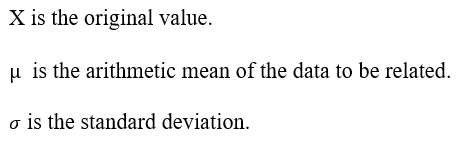
Results
Correlation Analysis
Before analyzing the correlation, it is necessary to describe the figures related to recent intradepartmental migration in Pasto. According to the 2018 CNPV (DANE, 2018), this city recorded 13,104 intradepartmental migration movements. Of these, 7,383 corresponded to changes of residence to the capital (53.6%), while 5,676 were departures from it to settle in other municipalities of the department (46.4%). In summary, recent intradepartmental inflows and outflows resulted in a net migration of 1,707 people; although positive, this balance represented a very low contribution to the city's population growth. This fact is corroborated by the migration efficiency index which, in this case and despite its limitations, was close to 0 (0.130) (Rodríguez, 2023).
According to Figure 1, recent immigrants reported to the census that their municipality of residence five years prior was mainly in Ipiales, Tumaco, Túquerres, Guaitarilla, Samaniego, and Buesaco. Except for Tumaco, the other municipalities are located near Pasto. It is worth noting that, when analyzing the figure at the municipal level, this was a case of recent interurban immigration, as the largest number of immigrants came from the second and third most important urban, economic, and demographic municipalities in the region (1,438 people, approximately 19%). However, when adding the number of newcomers from the remaining 61 municipalities, the migration was predominantly rural-to-urban (5,945 people, equivalent to 81%).
A similar pattern was observed with emigration. Those who reported to the census that they had lived in Pasto five years prior but by 2018 resided in the department’s two largest urban centers totaled 788 people, representing 15%. However, as shown in Figure 1, many relocated to nearby municipalities such as Chachagüi, Tangua, and Buesaco, as well as to more distant ones like La Unión. Quantitatively, the number of people who moved from Pasto to other municipalities in Nariño (recent intradepartmental urban-to-rural emigration) reached 4,488 people (85%), a figure approximately six times higher than interurban emigration (Pasto–Tumaco and Pasto–Ipiales).
Figure 1
Recent Immigration and Emigration
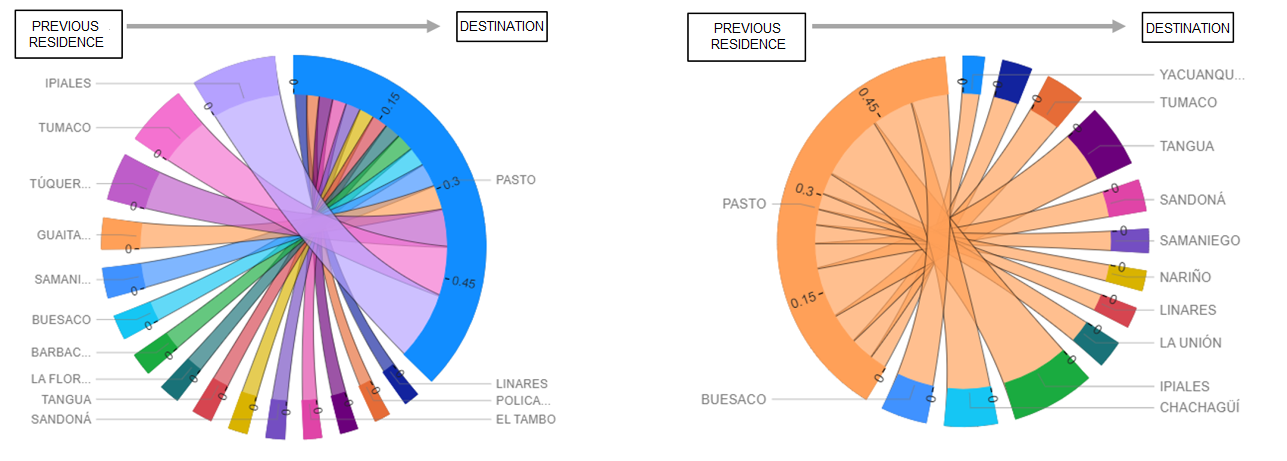
Source: Prepared by the author based on the origin-destination matrices of the MIALC system (CELADE, 2018).
According to sex, both in the changes of residence to Pasto and in the departures of people who had been residing in this departmental capital five years earlier, women represented a slight majority over men, with a ratio in their favor of 52.18% and 50.71%, respectively.
Likewise, the city experienced inflows and outflows mainly involving the working-age population. Immigration was primarily composed of individuals aged 30 to 34 (52%), followed to a lesser extent by those between 35 and 39 years old (23.8%) (Figure 2).
The age structure of people who emigrated from Pasto to other municipalities in the region showed a different composition. While a significant group of emigrants from the city was between 30 and 34 years old (35.5%), this segment was surpassed by younger individuals aged 20 to 29 (46%).
Figure 2
Immigrants and Emigrants by Sex and Age
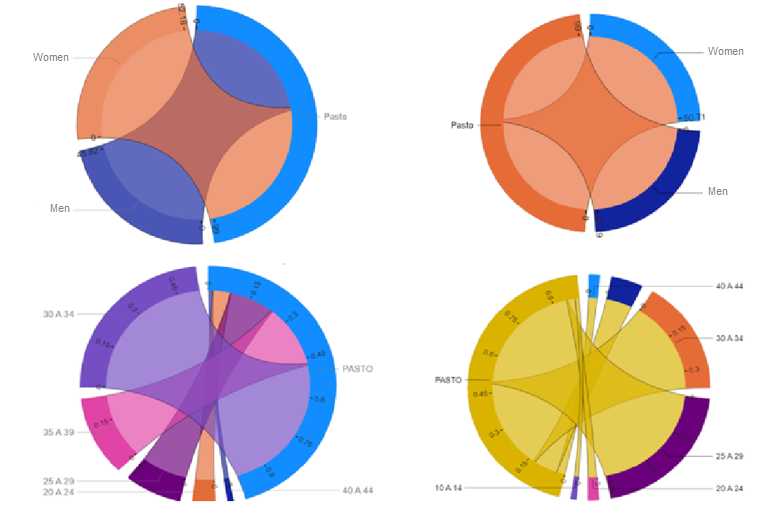
Source: Prepared by the author based on the origin-destination matrices of the MIALC system (CELADE, 2018).
High-Magnitude Correlations Between the Socioeconomic Context and Recent Intradepartmental Migration
In the five years preceding the 2018 CNPV, the tertiary sector of the economy exhibited high productivity, contributing more than 50% to the department's GDP (DNP, 2024b). In contrast, the industrial and manufacturing sectors showed low dynamism, even ranking below the primary sector (Annex 2).
At the municipal level, this economic shift toward the tertiary sector was evident. Out of 64 municipalities, 40—equivalent to 63%—were characterized by having more than 50% of their production derived from this sector. Municipalities along the Pacific coast, such as Mosquera (84.4%), and in the highlands, such as Ipiales (78.6%), had the most significant percentages (Annex 3).
Closely related to this was another socioeconomic challenge: the high proportion of informal workers, which consistently exceeded 90% over the observed five-year period. This starkly contrasted with formal employment, which never surpassed 5% (DNP, 2024b) (Annex 2). In 61 municipalities—representing 95% of the department—this informal economic activity characterized nearly the entire employed population. This trend was particularly prominent in the 10 municipalities of the Pacific region and in Policarpa (97.5%), Providencia (97.3%), and Cumbal (97.1%), located in the Andes Mountains (Annex 4).
Another key socioeconomic indicator was the coverage of basic education levels. Data revealed a significant gap between net enrollment rates for primary and secondary education (Annex 2). The lowest net primary education coverage was found mainly in highland municipalities such as Los Andes, Albán, and San Bernardo, with rates below 50 students per 1,000 enrolled children aged 6 to 10 (Annex 5). In contrast, in four Andean municipalities—Aldana, Gualmatán, Imues, and Guachucal—secondary education coverage significantly exceeded primary education enrollment rates.
Finally, another crucial indicator in this socioeconomic context was the type of health insurance (Annex 2). Similar to informal employment, the most striking aspect was the overwhelming reliance on the state-subsidized healthcare system compared to the contributory system funded by employers and formal workers. The subsidized system was prevalent in the 10 coastal municipalities, as well as in areas near Pasto, such as La Florida, El Tambo, Ancuya, El Peñol, Consacá, and Tangua (Annex 6). In contrast, Pasto recorded the highest percentage of contributory health system affiliates at the regional level.
Regarding the correlation analysis, Figure 3 highlights the high-magnitude positive and negative relationships between socioeconomic variables and recent intradepartmental migration in Pasto. On the positive correlation side, the contributory health insurance rate and the accumulated percentages of formal workers showed strong correlations with migration and emigration rates. Conversely, average net primary and secondary education coverage exhibited highly negative correlations with migration, immigration, and emigration rates for both men and women.
Additionally, Pasto’s lower levels of labor informality compared to other regions acted as a population attraction factor. However, despite the high levels of informality in the rest of the municipalities, this economic characteristic generally did not trigger massive migration to the capital (Figure 3).
Figure 3
Correlation Matrix Between Socioeconomic Variables and Intradepartmental Migration Indicators.
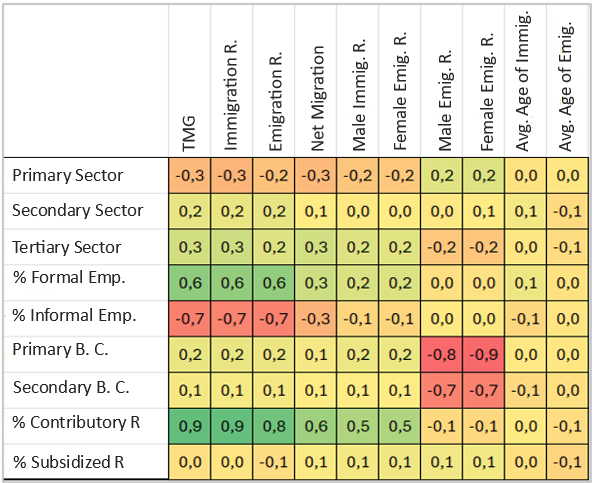
Source: Prepared by the author.
Medium-Magnitude Relationships Between Politics and Migration
Although there are several indicators through which the political reality of a region can be characterized, in departments like Nariño—marked in recent decades by violence caused by internal armed conflict and by poverty that in some municipalities coexists with extreme deprivation—the volume of displaced population, the number of hectares planted with coca, and the transfers the state allocated to this territorial entity allowed for a brief diagnosis of recent developments in this dimension of the context.
The volume of people displaced by violence showed a downward trend, decreasing from 27,647 to 26,040 individuals, representing a 5.8% decline (RUV, 2024) (Annex 7). All municipalities in Nariño were affected by this issue, but its intensity was greater in some areas. In certain regions, such as the Pacific coast, Tumaco emerged as the main recipient of this population. In others, like El Charco, Barbacoas, Magüí, Roberto Payán, and Santa Bárbara, the phenomenon intensified (Annex 8). Likewise, in the Andean region, municipalities such as Cumbal, Policarpa, Ricaurte, and Samaniego reported an average of 602 displaced persons in 2018.
On the other hand, one of the conflicts that unfortunately made the department notorious during the study period was the increase in the number of hectares planted with coca (Annex 7). In this regard, it is important to note that its extent grew significantly, rising from 499,000 hectares to 718,000—a 43.8% increase (approximately 219,000 hectares).
Not all municipalities in Nariño recorded this type of crop (Annex 9). As in the previous case, the issue was most intense in the Pacific region. In Barbacoas, El Charco, and Roberto Payán, the situation became particularly complex. Among these, El Charco experienced a sharp increase, going from just 12 hectares to 5,147 hectares in only five years (DNP, 2024b).
Similarly, national per capita transfers serve, as previously mentioned, as a proxy variable for measuring the investment that the state allocates to departments and municipalities across the country to finance, among other things, social programs and employment generation initiatives. These disbursements are made through the Sistema General de Participación [General System of Participation] (SGP). In simple terms, this data reflects the amount of resources the central government assigned per person to each territorial entity during the analysis period (DNP, 2024).
It was observed that state investment increased by 162.911 billion pesos (23.3%), resulting from the difference between the 699.893 billion pesos transferred in 2013 and the 862.804 billion invested in 2018 (Annex 7). At the municipal level, there was a heterogeneous distribution of transfers, with predominantly rural municipalities being the most benefited (Annex 10).
Regarding the correlations between these indicators and recent intradepartmental migration, it is worth noting that some of their linkages showed a medium-intensity positive association. This was the case for the relationships between the percentage of coca-planted hectares and net migration, the male immigration rate, and the female emigration rate (Figure 4).
Figure 4
Correlation Matrix of Political Context Indicators and Intradepartmental Migration
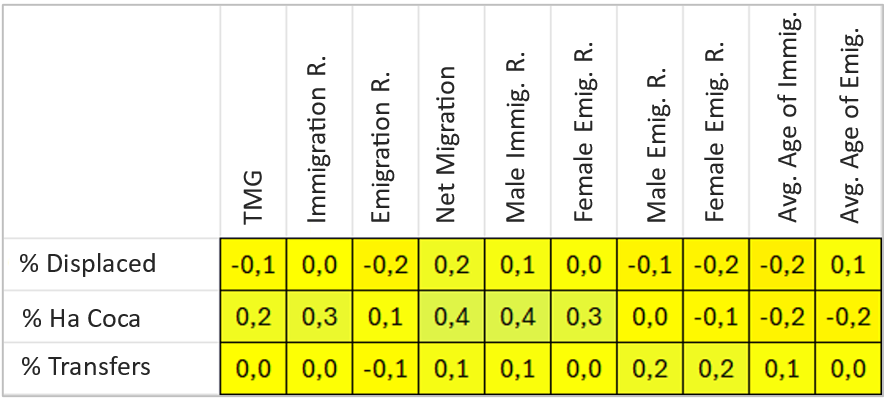
Source: Prepared by the author.
Low-Magnitude Associations Between Culture and Migration
The behavior of marital status and variations in higher education are proxy indicators of the regional cultural context. Regarding marital status, the highest rates were reported by men and women who stated that they were in a common-law union (Annex 11). When comparing this condition between the two genders, no significant differences were observed, as it was a widespread phenomenon in the municipalities along the Pacific coast and in the Andean foothill municipalities, such as Ricaurte, Mallama, and El Rosario (DNP, 2024a). Conversely, this was not a distinguishing characteristic of Pasto and its surrounding municipalities (Annex 12).
The rates of men and women in common-law unions were followed by the rates of married individuals of both genders. However, these presented opposite trends, as married individuals were mainly concentrated in the highland municipalities, particularly those close to Pasto. In this group, municipalities in the mountain range such as El Tambo, Ancuya, Túquerres, Funes, and Sapuyes stood out. In the Pacific region, Catholic and civil marriages occurred at very low frequencies, as described in Annex 13.
Similarly, the distribution of separated men and women across the territory was heterogeneous. Women separated more frequently than men and were similarly distributed in some coastal and highland municipalities. In the former, women from Mosquera stood out, while in the highlands, Mallama, El Tambo, La Unión, and Túquerres recorded the highest figures in this regard (Annex 14). In contrast, men were more evenly distributed, with a few exceptions such as Leiva, El Tambo, and Puerres.
Lastly, the rates of male and female university graduates also provided an indirect observation of the department’s cultural reality during the analyzed period. In this regard, differences in these indicators became more noticeable in 2017 and 2018 (Annex 11). The two groups exhibited heterogeneous growth, as women reported an increase of 15.14 percentage points, while men with this characteristic only increased by 5.06 percentage points (Sistema de Identificación de Potenciales Beneficiarios, 2024).
Despite these differences, professionals were generally distributed similarly across municipalities. However, some exceptions were noted, as the highest rates among women were reported in Córdoba, Aldana, and Ancuya. Regarding male university graduates, in addition to Aldana and Ancuya, the highest rates were recorded in Colón, Mallama, and Puerres (Annex 15).
Finally, the low-magnitude positive correlations between university graduates and male and female emigration rates are described (Figure 5). Evidently, a small proportion of those who arrived in the capital were seemingly individuals of both genders with professional degrees.
Figure 5
Low-Significance Correlations Between Cultural Context Variables and Intradepartmental Migration Indicators
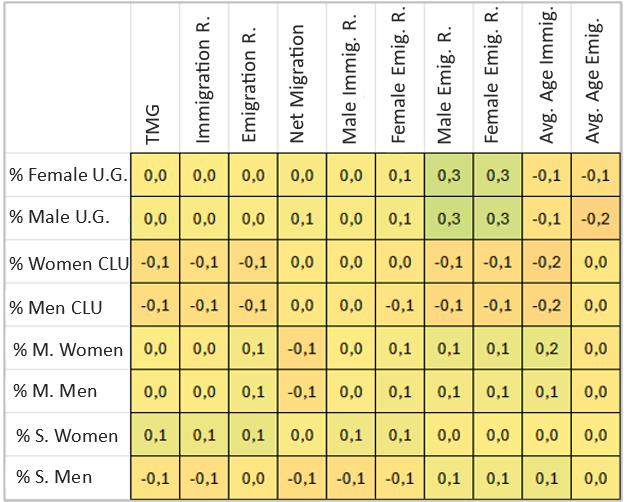
Source: Prepared by the author.
Conclusions
The correlation between the socioeconomic, political, and cultural context of Nariño and the recent intradepartmental migration of Pasto was analyzed. This exercise yielded findings and discussions in relation to the referenced research, as well as hypotheses and pending tasks that will provide continuity to the study of this relationship in future investigations.
Firstly, it was verified through Pearson’s correlation coefficient that not all the variables derived from the operationalization of the three contextual dimensions of the department were related to the migration indicators observed in this city during the five years preceding the 2018 CNPV.
The evidence showed that the strongest correlations were established between socioeconomic variables, such as the percentage of formal and informal workers and the percentage of people covered by contributory health insurance, and the migration, immigration, and emigration rates. Additionally, in this dimension, a strong association was observed between the net coverage rates for primary and secondary education and the emigration rates of both men and women.
However, while the percentage of formal workers and the percentage of those insured under the contributory health system were directly related to these demographic indicators, informal employment and net coverage in basic education showed an inverse relationship.
These findings provide empirical support for the hypothesis that the population arriving in the city did so, as investigated by Castro (2012) and Castellanos (2016) in the context of national internal migration, motivated by the search for better living conditions associated with employment opportunities offered by both the state and private enterprises. These opportunities entailed the fulfillment of all labor rights, including affiliation with a contributory health insurance provider.
The positive net migration of 1,707 people recorded in Pasto during the 2018 census year suggests, first, that this search for better conditions was more prevalent within the dynamics of rural-to-urban migration. Second, it does not disregard the fact that people also left the city to take up formal employment with contributory health coverage in Tumaco, Ipiales, and the remaining 61 municipalities, particularly those near the capital, where most of the population resided in rural areas.
The observations, as mentioned earlier, challenge the findings of Rodríguez (2002) and Rodríguez y Busso (2009), who argued that, in Latin America, recent residential shifts between cities are predominant. Within departments like Nariño, this generalization does not hold true, as most of the population lives in rural areas, and their likelihood of emigrating primarily leads them to the capital—characterizing the region by rural-to-urban migration.
However, the contrast between this source and the observed facts does not solely indicate a discrepancy; there is also room for convergence, as both perspectives agree that these types of migration were characterized by short-distance movements. This suggests that these migrations were undertaken by individuals facing poverty and social vulnerability.
Regarding the second aspect, as Villamil (2020) argues in the context of international migration—an argument that can be extrapolated to the population from the 63 municipalities of Nariño who reported in the census that, five years earlier, they had resided in Pasto—the frustration of not finding a job or not benefiting from the state’s employment programs in this intermediate Colombian capital, which would have provided economic and social stability, led them to return to their previous place of residence. These places were generally characterized by poverty, unemployment, and labor informality.
Most likely, they did not achieve their goal due to the reasons highlighted by Martínez (2006) and Maldonado et al. (2018), who state that, in Colombia, individuals arriving with limited financial resources, low levels of education, and no work experience had to compete at a disadvantage with a non-migrant workforce that was more qualified, experienced, and better adapted to the city's socioeconomic dynamics. These individuals were outcompeted in an already scarce informal job market and were unable to integrate into a highly selective informal economy—one in which, as in the jungle, only the strongest, most persistent, and most resourceful survive.
Nevertheless, Pasto’s high percentage of informal workers likely did not prevent the continuous influx of working-age individuals into the capital. As previously observed by Flórez (2000), CEPAL (2008), and Castro (2012), these migrants sought better living conditions compared to their previous place of residence, along with the hope of achieving job security within this type of economy. However, in such an informal economy, workers are not covered by any health system, retirement savings, or risk protection. According to the correlation matrix results, these migration patterns generally involved men and women with only primary and secondary education.
In departments like Nariño, which are characterized by poverty, unemployment, low levels of political leadership, and the geographical isolation of predominantly rural municipalities from their capital, the informal or "survival" economy, as in other regions of Latin America, was often the only means of subsistence in the city and the surrounding region (Espejo, 2022).
Unfortunately, the analyzed data only measured population movements and statistical relationships between the variables of the two dimensions. As a result, hypotheses concerning the precariousness of informal work in both Pasto and other municipalities in Nariño could not be empirically supported. Furthermore, it was not possible to determine whether the immigrants received by Tumaco, Ipiales, and the rest of the department’s municipalities were returning migrants. Future research may address these gaps with the support of ethnographic methodologies or more detailed municipal-level sociodemographic data.
On the other hand, variables that provided insight into the recent political context showed weak correlations with migration indicators. However, with moderate significance, it was found that Pasto’s population gains were associated with productivity and employment linked to coca cultivation in rural areas. According to Durán et al. (2014) and the Ministry of Justice (2018), this activity led to an influx of individuals and families from rural areas into Pasto, fleeing the violence associated with the illicit trade. As reported by INDEPAZ (2024), this activity resulted in alarming levels of forced displacement in the five years preceding the 2018 CNPV, particularly in 2017.
However, it is also possible that the high productivity of these illicit crops, as previously described, motivated residents of the capital—often impoverished and unemployed—to migrate to coca-growing areas in search of work. Contrary to the national characterization by UNDOC (2018), in Nariño, men were more likely to migrate, particularly to the Pacific coastal region of the department, as evidenced in Annex 8, to meet the labor demand generated by this illegal economy. Nonetheless, based on the findings of this study, it can be asserted with some degree of certainty that many left Pasto as heads of households, poor, with low levels of education, and accompanied by their partners, who assumed caregiving roles for their children. In doing so, they exposed themselves and their families to social stigma and human rights violations.
Similarly, the proxy variables for the cultural context showed minimal relevance to recent intradepartmental migration from Pasto, to the extent that it can be concluded that they had no significant connection during the study period. However, within this broader picture of migration patterns in the five years preceding the census operation, one notable trend was the relocation of a portion of university-educated individuals to other municipalities within the department. It is likely that the migration of these professionals, both men and women, resulted from a voluntary decision. The motivation behind this shift may have been linked to the availability of skilled employment opportunities and the potential for further professional advancement, particularly in positions within municipal administrations.
In conclusion, a hierarchy was observed in the correlation between the two dimensions analyzed. The strongest correlations were found between certain socioeconomic indicators and intradepartmental migration, with Pasto as either the place of origin or recent destination. In contrast, the associations between the political and cultural contexts and this demographic determinant were of moderate to minimal significance.
Ethical Considerations
This research did not require ethical endorsement because it worked with freely available official information.
Source of Funding
This article was funded with the author's personal resources.
For these Latin American demographers, rural-to-urban migration has entered a period of decline in the region, at the expense of growing migration between large and medium-sized urban centers.
References
(1) Alcaldía municipal de Pasto. (2016). Plan de Desarrollo Municipal “Pasto constructor de paz” 2016-2019. https://concejodepasto.gov.co/wp-content/uploads/2018/01/Acuerdo-012-de-2016-PLAN-DE-DESARROLLO-2016-2019.pdf
(2) Álvarez, Y. y Castro, D. C. (2020). Frontera resistencia y vulnerabilidad de mujeres migrantes emprendedoras en Colombia. Revista Venezolana De Gerencia, 25(90), 427-445. https://doi.org/10.37960/rvg.v25i90.32387
(3) Angulo, A. y Lopez, D. (2018). Tumaco, del paraíso al infierno. https://www.cinep.org.co/publi-files/PDFS/20181201_articulo10.pdf
(4) Ayala, S. (2020). Estadística. Unidad 7 Medía Geométrica. Escuela Superior Tepeji del Rio. https://www.uaeh.edu.mx/division_academica/educacion-media/repositorio/2010/6-semestre/estadistica/media-geometrica.pdf
(5) Blanco, D. (2014). La migración interna contemporánea en Antioquia desde la perspectiva de la teoría de sistemas. Revista de Antropología y Sociología: Virajes, 16(2), 297-327.
(6) Briones, G. (2006). Métodos y técnicas de investigación para las ciencias sociales. Editorial Trillas.
(7) Castellanos, E. (2016). La migración interdepartamental en Colombia. Un estudio demográfico según el Censo 2005. Universidad Externado de Colombia. Centro de Investigaciones sobre Dinámica Social. https://bdigital.uexternado.edu.co/handle/001/1987
(8) Castro, E. (2012). Patrones de migración interna en Colombia [Tesis de maestría, Universidad de Manizales]. https://surl.li/yjbcrr
(9) Castro, E. (2016). Transformaciones territoriales y procesos de metropolización en Colombia: una aproximación a partir de la migración interna. Civilizar: Ciencias Sociales y Humanas, 16(31), 127-150. https://doi.org/10.22518/16578953.646
(10) Cohen, N. y Gómez, G. (2019). Metodología de la investigación ¿para qué? La producción de los datos y los diseños. https://biblioteca.clacso.edu.ar/clacso/se/20190823024606/Metodologia_para_que.pdf
(11) Comisión Económica para América Latina y el Caribe [CEPAL]. (2008). Transformaciones demográficas y su influencia en el desarrollo en América Latina y el Caribe. https://www.cepal.org/es/publicaciones/2894-transformaciones-demograficas-su-influencia-desarrollo-america-latina-caribe
(12) Cuervo, Z., Barbierli, A. y Ranjel, J. (2018). La migración interna en Colombia en el siglo XXI. Una aproximación multiescalar. Revista Latinoamericana de Población, 12(22), 50-68. https://doi.org/10.31406/n22a4
(13) Departamento Administrativo Nacional de Estadística [DANE]. (2018). Censo Nacional de Población y Vivienda 2018. http://systema59.dane.gov.co/bincol/RpWebEngine.exe/Portal?BASE=CNPVBASE4V2&lang=esp
(14) Departamento nacional de planeación [DNP]. (2024a). Sistema de Potenciales Beneficiarios de Programas Sociales (SISBEN). https://anda.dnp.gov.co/index.php/catalog/INVENT_SES
(15) Departamento nacional de planeación [DNP]. (2024b). Terrida. https://terridata.dnp.gov.co/
(16) División de Población de la CEPAL [CELADE]. (2018). MIALC 2.0 | Migración Interna en América Latina y el Caribe, Colombia 2018 | División Administrativa Menor (DAME). Naciones Unidas. https://celade.cepal.org/bdcelade/mialc/
(17) Durán, J., Velázquez, I. y Loaiza, R. (2014). Influencia de la ganadería, la minería y la presencia de cultivos de coca y grupos armados ilegales sobre el desplazamiento forzado en Colombia en 2011. Magazín Empresarial, 10(23), 11-17.
(18) Eisenstadt, S. (1972). Modernización, movimientos de protesta y cambio social. Amorrortu.
(19) Espejo, A. (2022). Informalidad laboral en América Latina. Propuesta metodológica para su identificación a nivel subnacional. https://repositorio.cepal.org/server/api/core/bitstreams/b5e5aa09-8dd9-4ddf-84af-c9412db19f20/content
(20) Financiera de desarrollo territorial [FINDETER]. (2015). Plan de Acción 2038. Pasto recorrer el buen camino. 500 años de tradición. https://issuu.com/ciudadesemergentesysostenibles/docs/plan_de_acci__n_pasto_2038#:~:text=La%20plataforma%20Ciudades%20Sostenibles%20y,una%20visi%C3%B3n%20de%20largo%20plazo.
(21) Flórez, C. (2000). Las Transformaciones Sociodemográficas en Colombia. Tercer Mundo Editores.
(22) Flórez, C. y Sanchez, L. (2013). Fecundidad y familia en Colombia: ¿hacía una segunda transición demográfica? https://tinyurl.com/yecv69e5
(23) Flórez, C., Gomez, C. y Martinez, C. (2018). Análisis de situación de población. ASIS Colombia 2018. Colombia ASP. https://colombia.unfpa.org/sites/default/files/pub-pdf/ASPCOLOMBIA_GEN_web_4.pdf
(24) Fondo de población de las naciones Unidas [UNFPA]. (2023). Análisis de Situación de Población ASP 2023. https://colombia.unfpa.org/sites/default/files/pub-pdf/dindemo_presentacion_0.pdf
(25) Germani, G. (1969). Sociología de la modernización en América Latina. Estudios teóricos, metodológicos y aplicados a América Latina. Editorial Paídos.
(26) González, A. (2002). Elementos para el análisis demográfico para el estudio de las migraciones. UEC.
(27) González, L. (2013). Estadística descriptiva y probabilidad. https://www.utadeo.edu.co/sites/tadeo/files/node/publication/field_attached_file/pdf-_estadistica_descriptiva-_completo-_09-15.pdf
(28) Granados, J. (2010). Migraciones internas y su relación con el desarrollo en Colombia: una aproximación desde algunos estudios no clasificados como migración interna en los últimos 30 años. Pontificia Universidad Javeriana, https://repository.javeriana.edu.co/bitstream/handle/10554/664/eam27.pdf?sequence=1&isAllowed=y
(29) Instituto de Estudios para el Desarrollo y la Paz [INDEPAZ]. (2024). Contexto de violencia en Nariño. https://indepaz.org.co/wp-content/uploads/2024/04/CONTEXTO-DE-VIOLENCIA-EN-NARINO.pdf
(30) Maldonado, C., Martínez, J. y Martínez, R. (2018). Protección Social y Salud. Una mirada desde las vulnerabilidades a largo plazo del ciclo de la migración y de la vida de las personas. Documentos de Proyectos, Comisión Económica para América Latina y el Caribe [CEPAL]. https://www.cepal.org/es/publicaciones/44021-proteccion-social-migracion-mirada-vulnerabilidades-lo-largo-ciclo-la-migracion
(31) Martínez, C. (2006). Las migraciones internas en Colombia. Análisis territorial y demográfico según censos 1973 y 1973. Universidad Externado de Colombia.
(32) Ministerio de Justicia. (2018). Cultivos de coca. Estadísticas a nivel municipal. https://www.minjusticia.gov.co/programas-co/ODC/Documents/Publicaciones/Estad%C3%ADsticas%20municipales%202018.pdf
(33) Ministerio del Trabajo. (2014). Plan departamental de empleo para Nariño de Nariño. https://tinyurl.com/25c55zw7
(34) MPC. (2025). Mapas del departamento de Nariño. https://www.mapasparacolorear.com/colombia/mapa-departamento-narino.php
(35) Oficina de las naciones unidas contra la droga y el delito [UNDOC]. (2022). Monitoreo de territorios afectados por cultivos ilícitos 2021. https://www.unodc.org/documents/crop-monitoring/Colombia/INFORME_MONITOREO_COL_2021.pdf
(36) Oficina de las Naciones Unidas contra la Droga y el Delito [UNDOC]. (2018). ¿Quiénes son las familias que viven en zonas con cultivo de coca? https://www.unodc.org/documents/colombia/2018/Agosto/Quienes_son_las_familias_que_viven_en_las_zonas_con_cultivos_de_coca_N.1.pdf
(37) Registro único de víctimas [RUV]. (2024). Transparencia y acceso a la información pública. https://www.unidadvictimas.gov.co/transparencia-y-acceso-a-la-informacion-publica-2/
(38) Rodríguez, J. (2002). Distribución espacial de la población de América Latina y el Caribe: tendencias, interpretaciones y desafíos para las políticas públicas. CEPAL. https://repositorio.cepal.org/entities/publication/4a783b0e-11a0-4089-b02c-7c1069977076
(39) Rodríguez, J. (2023). Método para la medición de la migración interna, y sus efectos sociodemográficos, con especial atención al uso de censos y matrices de migración. https://repositorio.cepal.org/server/api/core/bitstreams/cf517c26-1873-4a74-8b7e-860b1282d07d/content
(40) Rodríguez, J. y Busso, G. (2009). Migración interna y Desarrollo en América Latina entre 1980 y 2005. Un estudio comparativo con perspectiva regional basada en siete países. https://repositorio.cepal.org/server/api/core/bitstreams/19202393-20f9-4514-b42f-401b71f31e2b/content
(41) Saavedra, A. C., Palós, A. E. y Gay, A. L. (2013). La unión libre en Colombia: 1973-2005. Revista Latinoamericana de Población, 7(13), 107-128, https://doi.org/10.31406/relap2013.v7.i2.n13.5
(42) Sánchez, Ó., Salazar, A. F., Thowinson, J., López Arango, J. M. y Villareal, S.O. (2018). Guía para la construcción y análisis de indicadores. Departamento Nacional de Planeación. https://colaboracion.dnp.gov.co/CDT/Sinergia/Documentos/Guia_para_elaborar_Indicadores.pdf
(43) Sistema de Identificación de Potenciales Beneficiarios. (2024). Terridata. https://terridata.dnp.gov.co/
(44) Van de Kaa, D. (2003). Second demographic transition. En P. Demeny, y G. Mcnicoll (Eds.). Encycplopedia of population. Thompson. https://www.eolss.net/sample-chapters/c04/E6-147-02.pdf
(45) Villamarín, F. y Ortega, X. (2024). Relación entre dinámica demográfica y modernización diferencial en Nariño. Una aproximación a su vínculo en las primeras décadas del nuevo milenio. Editorial Universidad de Nariño. http://sired.udenar.edu.co/id/eprint/15347
(46) Villamil, S. (2020). Migración de retorno de los colombianos (2012- 2018). https://www.researchgate.net/publication/342216340_Panorama_de_la_migracion_de_retorno_de_colombianos_2012-2018
(47) Zúñiga, E. (2002). Nariño: Cultura e Ideología. Universidad de Nariño, Gobernación de Nariño, Alcaldía Municipal de Pasto y Fundación para la Investigación y el Desarrollo de Nariño. FIMIL.
Anexxes
Anexx 1
Municipalities of the Department of Nariño
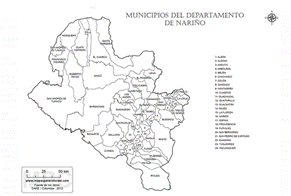
Source: MPC (2025).
Anexx 2
Recent Trends in Selected Socioeconomic Indicators
Indicator |
2013 |
2014 |
2015 |
2016 |
2017 |
2018 |
Economic Sector |
||||||
Primary Sector |
24,65 |
25,77 |
26,66 |
29,75 |
29,33 |
27,00 |
Secondary Sector |
11,35 |
11,33 |
11,32 |
11,31 |
10,66 |
10,46 |
Tertiary Sector |
55,26 |
54,38 |
52,63 |
50,33 |
52,89 |
53,92 |
Type of Employment |
||||||
Formal Employment |
4,21 |
4,47 |
4,86 |
3,43 |
3,94 |
3,74 |
Informal Employment |
95,13 |
94,72 |
94,12 |
95,34 |
94,70 |
94,62 |
Net Enrollment Rate |
||||||
Primary Net Enrollment |
64,14 |
70,32 |
68,54 |
65,48 |
62,60 |
60,41 |
Secondary Net Enrollment |
50,78 |
52,16 |
52,69 |
53,58 |
54,49 |
53,55 |
Health Insurance |
||||||
Contributory |
3939 |
4004 |
4159 |
4235 |
4092 |
4133 |
Subsidized |
204296 |
209648 |
217552 |
214121 |
218364 |
223120 |
Source: Prepared by the author based on DNP (2024).
Anexx 3
Cumulative Percentage of the Three Economic Sectors at the Municipal Level
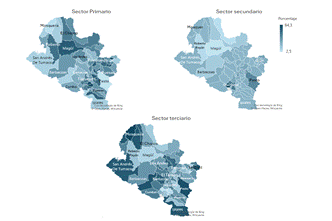
Source: Prepared by the author based on DNP (2024).
Anexx 4
Cumulative Percentage of Formal and Informal Workers at the Municipal Level
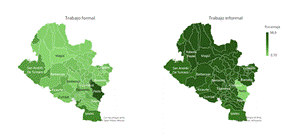
Source: Prepared by the author based on DNP (2024).
Anexx 5
Cumulative Net Coverage of Primary and Secondary Education at the Municipal Level
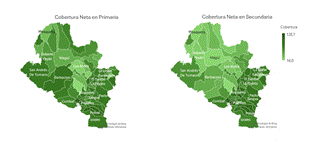
Source: Prepared by the author based on DNP (2024).
Anexx 6
Cumulative Rates of Contributory and Subsidized Insurance Systems
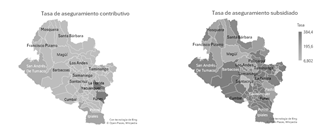
Source: Prepared by the author based on DNP (2024).
Anexx 7
Behavior of Some Political Context Indicators
Indicator |
2013 |
2014 |
2015 |
2016 |
2017 |
2018 |
Forced Displacement |
29.647 |
36.622 |
27.721 |
27.721 |
20.262 |
26.040 |
Ha of Coca Cultivation |
499.000* |
601.000* |
545.000* |
1.556.000* |
1.310.000* |
|
Per Capita National Transfers |
699.893 |
659.025 |
718.902 |
765.443 |
852.703 |
862.804 |
Source: Prepared by the author based on DNP (2024).
Anexx 8
Behavior of Forced Displacement at the Municipal Level, 2013–2017
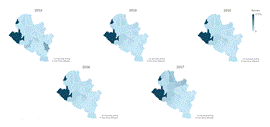
Source: Prepared by the author based on DNP (2024).
Anexx 9
Behavior of the Number of Hectares Planted with Coca at the Municipal Level, 2013 to 2018.
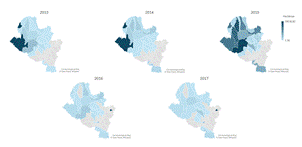
Source: Prepared by the author based on DNP (2024).
Anexx 10
Behavior of Per Capita National Transfers at the Municipal Level, 2013 to 2017.
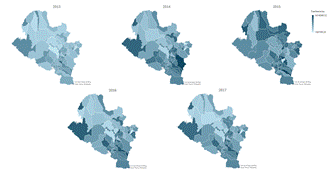
Source: Prepared by the author based on DNP (2024).
Anexx 11
University Graduates, Common-Law Unions, Married, and Separated by Gender (2013-2018): Proxy Variables of the Cultural Context
Indicator |
2013 |
2014 |
2015 |
2016 |
2017 |
2018 |
Female University Graduates |
94,34 |
101,05 |
100,94 |
108,30 |
112,06 |
109,48 |
Male University Graduates |
94,00 |
99,46 |
97,15 |
103,09 |
104,19 |
99,06 |
Women in Common-Law Unions |
136,82 |
136,30 |
135,79 |
135,26 |
134,74 |
134,24 |
Men in Common-Law Unions |
178,81 |
170,24 |
161,87 |
153,67 |
145,67 |
137,86 |
Married Women |
75,82 |
74,31 |
72,83 |
71,37 |
69,95 |
68,56 |
Married Men |
75,19 |
73,73 |
72,31 |
70,90 |
69,53 |
68,20 |
Separated Women |
9,90 |
9,68 |
9,47 |
9,26 |
9,05 |
8,89 |
Separated Men |
4,73 |
4,65 |
4,58 |
4,51 |
4,44 |
4,37 |
Source: Prepared by the author based on SISBEN Surveys, DNP, and CNPV 2018. DANE.
Anexx 12
Cumulative Percentage of Women and Men in Common-Law Unions
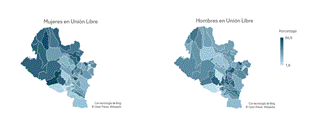
Source: Prepared by the author based on Survey
Anexx 13
Cumulative Percentage of Married Men and Women at the Municipal Level

Source: Prepared by the author based on SISBEN Surveys.
Anexx 14
Cumulative percentage of separated women and men at the municipal level
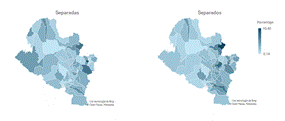
Source: Prepared by the author based on SISBEN Surveys.
Anexo 15
Cumulative percentage of separated women and men at the municipal level
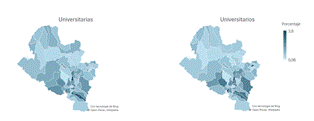
Source: Prepared by the author based on Survey